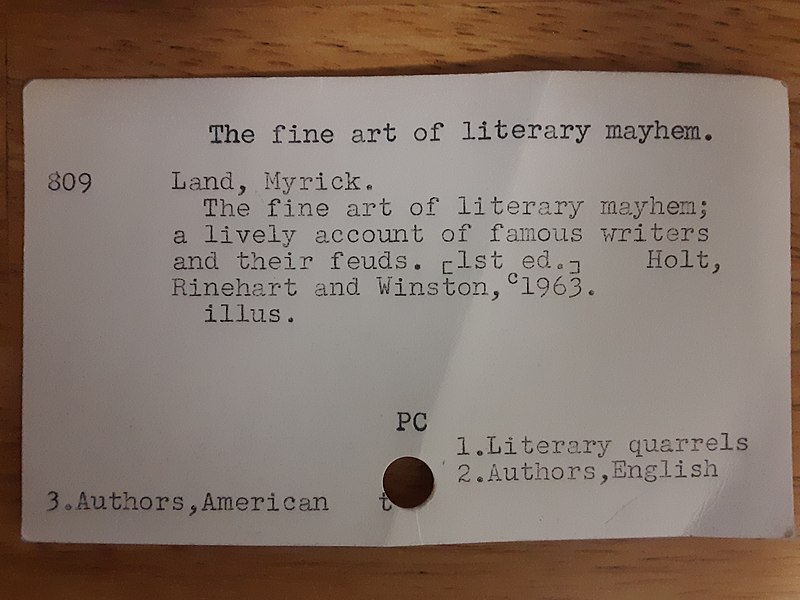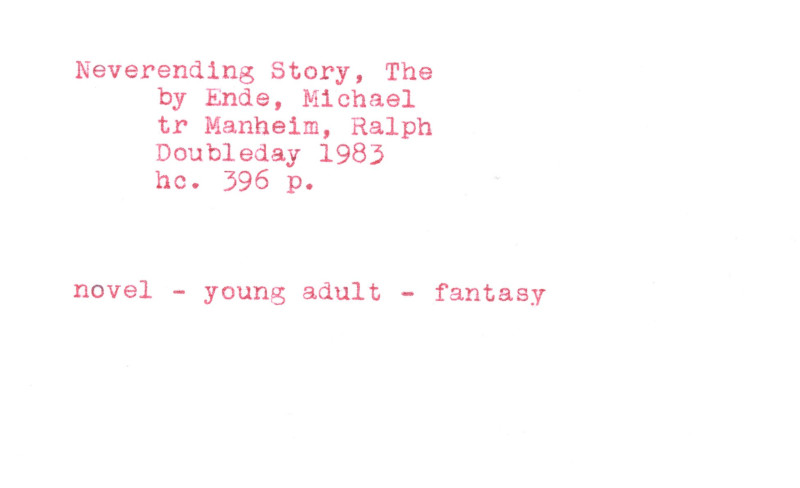
Making a card catalogue probably sounds like purgatory to most people. It’s unnecessary, obsolete, a lot of work, and useless since this is a personal library and I already know what books I have. Maybe it’s the library school student in me talking but it’s also a lot of fun. I get to reflect on each book in the collection; I get to use my granddad’s old typewriter to do something constructive instead of letting it sit around like a retro hipster ornament; I get to design my own cataloguing system; I get to use one of those gorgeous old card catalogues; and, what a shocker, my catalogue might even be useful. After all, if I want to know if I have a specific short story by Alfred Bester in one of my anthologies, or how many books I have by Stanisław Lem that were translated by Michael Kandel, there’s currently no way of knowing. But one day my card catalogue will do exactly that.
I made a deliberate decision not to use the traditional format for an index card. Yes, there’s something to be said for standardisation, but no-one will use this catalogue except me so the only thing that matters is what I find useful and intuitive. Standard index cards are cluttered and difficult to read, they contain a lot of information I don’t care about, and they contain metadata that don’t apply to my library such as call numbers. So what am I going to put on these things?

It would be nice to encode as much relevant information as possible in a concise and accessible way. I started by considering what variables I have at my disposal:
- card colour
- text colour (the typewriter can switch between black and red)
- card order
- drawers
- text
The drawers were probably the easiest. I’d bought a disused card catalogue off eBay that had four drawers, so I could potentially have four different sets of cards. One should obviously contain a card for every physical book. One should have card/s for each contributor to those books. And although I haven’t quite got that far, I would like to have another drawer for each short-form work, such as an essay or short story, that might appear in a book. This leaves a whole drawer free in case there winds up being an overflow, which is distinctly possible in the case of the book drawer.
The text colour is binary (black or red) so this would be suited best to representing a binary piece of data. A natural fit here is distinguishing the fiction books from the non-fiction. This level of granularity is perfect because it applies not only to the book cards, but when I come to writing the contributor cards I can list the contributor’s works in both black and red ink on the same card.

I’ll confess the card colour is the one that threw me for the longest time. I did consider using different colours for fiction, non-fiction, and author cards, but those data were better represented by other variables such as ink for fiction vs. non-fiction, and drawer number for books vs. contributors. Then I thought about using the card colour to represent genres or subjects. This seems like a much more feasible idea as there could be a large number of colours at my disposal. And if a book covers multiple subjects, then the colour could be a combination of both its subjects’ colours! If science fiction is red and humour is blue, then a science fiction comedy novel would be on a purple card. Mercifully sanity intervened at this point. Dealing with a score of different colours and colour combinations sounded like a recipe for chaos, and anyway, what would be the point? I already know what my books are about because I bought them. I also came to the realisation here that I wanted my cataloguing system to be self-evident. You shouldn’t need a key to figure out what the metadata on a card mean — you should be able to tell by looking at it. So with some regret I scrapped the use of coloured cards and decided just to use white ones (obtained the same day from the discount stationery, furniture, and perfume outlet up the street from us).
I had so many dreams for the card order as well. Imagine being able to rearrange your library without having to rearrange the books! There are so many constraints on my physical arrangement — the size of the books in relation to the shelf, books I inherited from my dad that I’d like to keep together, books in a series that should be in numerical order, books that I don’t want very often so can go behind the first layer of books, even cases where it’s more space-efficient to stack books that would otherwise take up too much horizontal space and leave a lot of vertical space on the shelf. But my cards — they can go in any order. Imagine being able to group them at will, to arrange the entirety of human knowledge into a spectrum where each book flows seamlessly into the next! That has only two small problems: one, it’s bonkers; human knowledge doesn’t come packaged in spectrums, it’s all over the damn place. And two, how in the name of sanity would you ever find anything? You’d have to guess where you decided a book’s subject fell on a made-up spectrum on a random day three years ago. It’d never work. As with the card colours, then, I had to give up on being fancy and just file everything alphabetically like a regular old drudgeon.

Everything that’s not already accounted for, then, has to be typed onto the card itself. It’s time to decide what other metadata I wanted in my catalogue:
- title
- author
- editor
- translator
- publisher
- year of publication
- hardcover vs. paperback
- number of pages
- edition
- series
Most of these are no-brainers. Obviously they don’t all apply all the time (e.g. there won’t always be a translator) so each card won’t have exactly the same layout, but on the whole the same information should go in the same spot on the card each time. With this in mind I decided that the title should have no indent because it’s the most important piece of information, but that the other metadata should be indented by one tab stop. (FYI: on the typewriter tab stops are literal stops; there are little clips behind the mechanism that you can rearrange to stop the carriage at specific points.) I use two-letter codes for the contributor roles (“by” for the author, “ed” for the editor, “tr” for the translator, and “il” for the illustrator) because this would allow contributor names to line up on the card. I also decided that if there were more than one contributor with the same role, I would not repeat the role code but indent the second person’s name by three additional spaces so it would line up with the entry above it.

The series is important to me because I can record which number it is in the series, which I don’t always remember off the top of my head. The publisher was one I could take or leave. I don’t have an immediate use for it, but I decided to record it anyway because it couldn’t hurt.
A key decision I made was to avoid mixing semantics. A card may have more than one piece of data on the same line, e.g. “Avon 1978” to represent the publisher and the year, but I should not have “100 h” or “100 p” to indicate a hardcover or paperback with a hundred pages. That notation would be more compact, but it uses one piece of semantic data (the binding) to represent another. Furthermore it would not be self-evident to a casual viewer, which goes against one of my guiding principles.
I did not leave any room for a free-form notes section the way traditional cards do, but what I did do is add a section underneath the regular metadata for any tags I might want to associate with the book. Because this isn’t a computerised system and doesn’t have to be exchangeable with any other institutions, using the exact same terms consistently (what cataloguers call a controlled vocabulary) isn’t a strict necessity. However I like things to be consistent, so I picked some conventions for the tags and stick to them as much as possible. I got a bit wibbly here with the separation of concerns. The upper half of the card has to do with factual and physical attributes of the book — the title, the page count, the edition, etc. The tag section is vaguer and more relative — genre and form. Still, there is a bit of cross-over here that still irks me because if the book is signed I’ll put “inscribed” in the tag section. Technically that is factual and physical, so I feel like it properly belongs in the upper section, but at the same time I feel like it’s less important than the other data in that section and the signature is not an innate property of the book — it’s something that happened to it later.

The process of choosing what to tag and what not to tag revealed the biases of the cataloguer in short order. The biases of classification schemes like Dewey Decimal and the Library of Congress are notoriously problematic, but happily I’m not the Library of Congress so I don’t have anything too egregious to apologise for. I did not, for example, tag the language of every book because 99% of them are in English and there wouldn’t be much point in that. I can, however, tag specific books that are in other languages like Polish or Esperanto because they are the exceptions. I also tagged Aussie books because that’s something relevant to me, and I tagged books that came from other collections so I’ll know where they’re from if I decide to shelve them separately.
Which brings us up to the present day! I’ve so far catalogued two of my four bookcases, but I suspect this represents more than half my library because the first bookcase has a bunch of books stacked behind the first row. Using a ruler to measure the width of a card and the depth of the drawer I’ve filled so far (stop, you’re blinding me with science!), I’d estimate that I’ve catalogued over six hundred books so far. I’m still only on the book drawer, too. After this is done, I’ll have to go through each of those cards and type up author card/s listing all that author’s works. Then, if I’m not dead yet, I’ll go through each anthology and catalogue the individual stories in them, though I regard this step as a (very) nice to have option rather than a necessity.

It’s been an immensely satisfying undertaking. When you’re a collector it’s very easy to stick what you have on a shelf and never look at it again, or look at it only when you view your collection as a whole. Maybe you’ll take the odd book off the shelf once in a while to look at it more closely, but once you’ve read something it doesn’t often get another go. We rarely have the opportunity to look at everything in our collections one item at a time. It is a lot of fun and it makes you appreciate the beauty and the value of every book, not to mention the amount of work that generations of benighted librarians have undertaken before you in cataloguing libraries around the world.